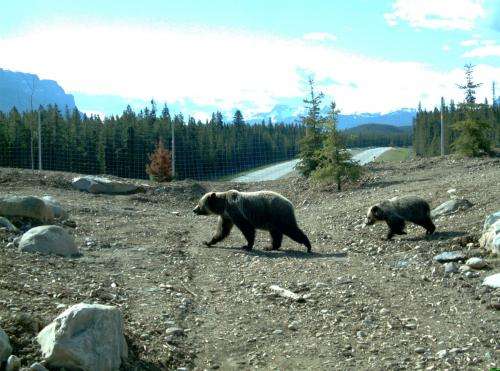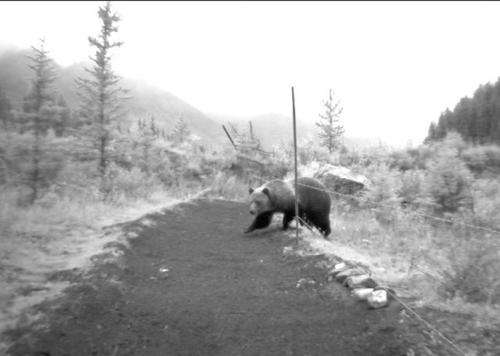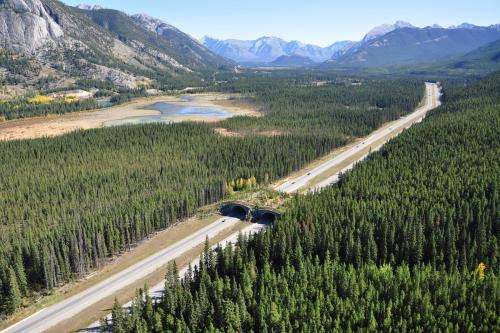Study proves that wildlife crossing structures promote 'gene flow' in Banff bears

(Phys.org) —A first-of-its-kind study of Banff National Park bears by scientists with the Western Transportation Institute at Montana State University has shown that a system of wildlife crossing structures there is helping to maintain genetically healthy populations of bears spanning the Trans-Canada Highway.
The findings of the MSU genetics study, which collected some 10,000 hair samples from black bears and grizzlies, have been published in the British journal Proceedings of the Royal Society B, and a photograph of one of Banff's wildlife overpasses is featured on the publication's cover.
"Showing that the black bears and grizzlies using the crossings to traverse the highway are also breeding is a major finding," said former MSU graduate student and WTI scientist Michael Sawaya, who wrote the paper as the final piece for his doctorate in ecology. "While there have been a lot of studies showing that wildlife are using these crossings, this is the first time anyone has shown that animals using the crossings are breeding often enough to ensure that the populations on either side of the highway are not being genetically isolated."
MSU professor of ecology Steven Kalinowski, who was Sawaya's doctoral adviser and co-authored the paper, agreed that the genetic evidence offers the best indication to date of the success of Banff's system of wildlife crossing structures.
The crossings – there are currently 44 in all – form the most extensive system of wildlife crossing structures on the planet. In addition to reducing collisions, the crossings project was designed to prevent fragmentation of wildlife populations living along Canada's busiest highway. Grizzly bears, Banff's marquee predator, are often negatively impacted by roads, Kalinowski added, so any true measure of the project's success has to account for the impact on that population, which the Alberta government currently lists as threatened.

"These wildlife crossing structures cost millions of dollars and this is one of the first studies that has shown that they are doing what they are intended to do," Kalinowski said. "If the bears aren't crossing the road and breeding, you're going to have fragmented and inbred populations on each side of the road."
The genetics paper is the third to come out of a three-year study of the crossings in the context of Banff's black bear and grizzly populations. The project was launched in 2006 by Sawaya, Kalinowski and WTI researcher Tony Clevenger, as a continuation of long-term research Clevenger has conducted in Banff since 1996. Previous papers discuss findings that show the number of bears in the Bow Valley and the proportion moving across the highway.
The final paper, which focuses on the flow of genes through the population, was able to highlight how many of the bears that crossed the Trans-Canada Highway had sired or birthed cubs. The WTI group extracted DNA from hair samples collected at wire snares located at the crossings and compared those data with the DNA from samples collected far and wide within the surrounding habitat on both sides of the highway.
Sawaya said some individuals did more than others to show they were comfortable finding mates on either side of the highway. One particular black bear male was particularly keen to do his part, with paternity tests revealing that he had mated with five different females in the process of siring 11 cubs.
Sawaya said the study also reinforced a common assumption among ecologists that grizzly bears are much more shy of human infrastructure than black bears, though project data suggest that once an individual grizzly is accustomed to using the crossings, that bear will cross the highway readily and, in the case of females, may pass the habit on to offspring. In all, parentage tests showed that 47 percent of black bears that used crossings had successfully bred, while 27 percent of grizzly bears had done so.

Sawaya said having the paper accepted into a prestigious international journal is a welcome culmination to his studies at MSU.
"It's really nice to end it on high note," Sawaya said. "Publishing my last dissertation chapter in such a well-respected journal is very gratifying to me and being featured on the journal's cover is great recognition of a cooperative effort by WTI, Parks Canada and various conservation foundations to assess the success of the crossing structures."
Kalinowski said the study also reflects well on the type of scientists coming out of MSU's ecology program.
"MSU has proven once again it is really good at producing young researchers that can do top-notch science while working in the field in very arduous conditions, whether it's tracking wolves in Yellowstone on snowshoes when it's 20 below zero or drilling through the Antarctic ice sheet to study glacial lakes or, as Mike Sawaya has shown, hiking into remote valleys in the Canadian Rockies to study the movement and mating of grizzly bears," Kalinowski said.
More information: Genetic connectivity for two bear species at wildlife crossing structures in Banff National Park, rspb.royalsocietypublishing.or … .1098/rspb.2013.1705
Journal information: Proceedings of the Royal Society B
Provided by Montana State University
















